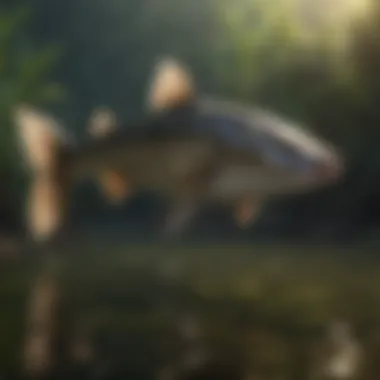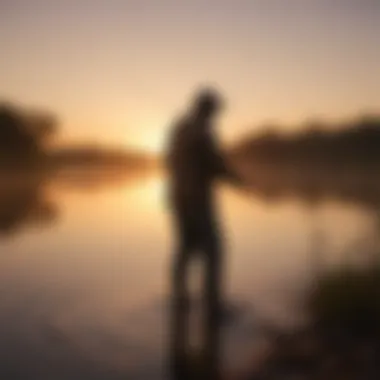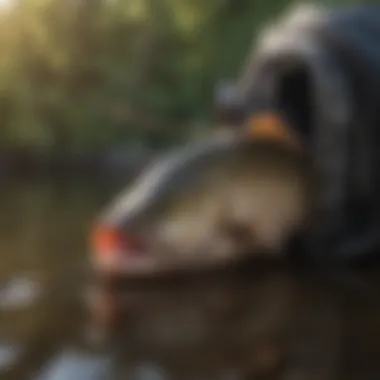Discover the Prime Time of Day for Catfish Fishing


Importance of Timing in Catfish Fishing
Catfish, known for their nocturnal feeding habits, are generally more active during dawn and dusk, making these periods ideal for fishing. Understanding the behavioral patterns of catfish can be instrumental in determining the most opportune times to set out for a fishing expedition. Factors such as water temperature, weather conditions, and lunar phases play crucial roles in influencing catfish activity levels. By aligning fishing efforts with these natural cues, anglers can maximize their chances of a productive fishing trip.
Synchronizing with Catfish Behavior
To excel in catfish fishing, anglers must synchronize their fishing schedule with the natural behavior of the fish. The crepuscular activity of catfish makes early mornings and late evenings prime fishing times. During these periods, catfish venture closer to the shoreline in search of food, presenting anglers with a strategic advantage. By capitalizing on these windows of heightened catfish activity, anglers can significantly boost their success rates and enjoy a fulfilling fishing experience.
Environmental Factors Influencing Catfish Feeding
The feeding behavior of catfish is intricately linked to various environmental factors, such as water temperature and flow rate. Catfish are ectothermic creatures, meaning their body temperature fluctuates based on the surrounding environment. As such, they tend to be more active in warmer water temperatures. Additionally, factors like oxygen levels and currents can also impact catfish feeding behavior. By gauging these environmental parameters and adjusting their fishing strategies accordingly, anglers can optimize their chances of enticing catfish bites.
Leveraging Natural Cues for Fishing Success
Successful catfish anglers leverage a combination of knowledge, experience, and intuition to capitalize on natural cues for fishing success. By monitoring weather patterns, understanding lunar influences, and adapting to seasonal variations, anglers can fine-tune their fishing approach and increase their likelihood of a rewarding catch. Embracing the nuances of catfish biology and ecology is key to unlocking the full potential of catfish fishing, making each outing a learning opportunity and a step towards mastery of this beloved pastime.
Introduction
In the realm of catfish angling, understanding the optimal time of day to embark on a fishing excursion is paramount. This crucial aspect can make the difference between a successful catch and a futile endeavor. By delving into the nuances of catfish behavior and environmental factors, anglers can elevate their fishing game to new heights.
Catfish, revered for their elusive nature and powerful dwellings in freshwater bodies, present a challenge that beckons dedicated anglers seeking a thrilling catch. This article aims to dissect the intricacies of when to seek out these formidable creatures, equipping anglers with the knowledge needed to maximize their chances of a bountiful haul.
Understanding Catfish Behavior Understanding the behavior of catfish is paramount in the realm of fishing. Being adept in the intricacies of catfish behavior equips anglers with a strategic advantage. By delving into the feeding habits and habitat preferences of catfish, anglers can decipher the opportune moments and locations for a successful catch. Understanding catfish behavior is akin to unraveling a puzzle - each piece revealing vital information that guides anglers towards a fruitful fishing endeavor.


Feeding Habits Catfish exhibit diverse feeding habits that play a pivotal role in their overall behavior. Understanding these feeding tendencies is crucial in determining the best times to fish for catfish.
Nocturnal Feeding Catfish are renowned for their nocturnal feeding behavior, being most active during the cover of night. This nocturnal proclivity is a fascinating aspect of catfish behavior, significantly impacting the optimal fishing times for catfish. Their preference for feeding under the veil of darkness poses both challenges and advantages for anglers, requiring keen observation and strategic planning to capitalize on this behavior.
Opportunistic Feeders Catfish are opportunistic feeders, displaying a tendency to capitalize on available food sources. This adaptive trait makes them versatile in their feeding patterns, allowing them to thrive in various environmental conditions. Recognizing catfish as opportunistic feeders is instrumental in designing effective fishing strategies tailored to exploit this behavior, maximizing the chances of a successful catch.
Habitat Preferences Delving into catfish habitat preferences unveils crucial insights into their behavior and movement patterns. By understanding where catfish dwell, anglers can pinpoint prime locations for fishing, optimizing their fishing experience.
Deep Water Dwellers Catfish are known as deep-water dwellers, preferring the depths of lakes and rivers for shelter and sustenance. This habitat preference directs anglers to focus their fishing efforts in deeper waters, where catfish are likely to congregate. Understanding catfish as deep-water dwellers guides anglers towards strategic fishing spots, increasing the probability of a rewarding catch.
Structure Seekers Catfish exhibit a penchant for seeking refuge in underwater structures such as submerged logs and rock formations. This behavior of gravitating towards structures offers valuable cues to anglers on where to concentrate their fishing activities. Recognizing catfish as structure seekers aids anglers in identifying potential hotspots for fishing, enhancing their overall success rate.
Factors Influencing Catfish Activity
In understanding the best times of the day to fish for catfish, it is crucial to delve into the factors that influence their activity. Catfish behavior is deeply interconnected with environmental conditions such as temperature and light. By comprehending these influences, anglers can strategically plan their fishing trips to maximize their chances of success. Factors influencing catfish activity play a pivotal role in determining when and where catfish are most likely to be active, making them a fundamental aspect of this fishing pursuit.
Temperature
Optimal Temperature Range
The optimal temperature range is a key factor that significantly impacts catfish activity. Catfish are known to thrive in specific temperature conditions, with their behavior varying based on temperature fluctuations. Understanding the optimal temperature range for catfish is essential as it dictates their feeding patterns and movement within the water bodies. This range provides insight into the most favorable conditions for catfish to be actively feeding, making it a crucial consideration for anglers looking to enhance their fishing efficiency. By identifying and targeting the optimal temperature range, anglers can increase their chances of attracting catfish and improving their overall fishing experience.
Light Conditions
Impact of Light Intensity


The impact of light intensity is another significant factor that influences catfish behavior. Light plays a vital role in catfish activity, affecting their visibility, feeding habits, and movement patterns. Different light intensities can trigger varying responses in catfish, determining their level of activity at different times of the day. Understanding how light intensity impacts catfish behavior is imperative for anglers seeking to optimize their fishing opportunities. By considering the varying effects of light on catfish activity, anglers can adjust their fishing strategies accordingly to align with the most conducive light conditions for successful catfish angling.
Morning Fishing
Fishing for catfish in the morning can be a strategic endeavor that offers unique advantages to anglers. The early hours of the day present a window of opportunity where catfish tend to be more active, making it an optimal time to target these elusive species. As the sun rises, catfish often start moving around to search for food, aligning with their natural feeding behaviors. It is during this period that anglers can capitalize on the increased feeding activity of catfish, increasing their chances of a successful catch.
Moreover, morning fishing provides a tranquil and serene environment that enhances the overall fishing experience. The calming ambiance of the morning lake or river creates a sense of peace and solitude, allowing anglers to connect with nature on a deeper level. The cool morning air coupled with the soft chirping of birds amplifies the sensory experience, making it a refreshing way to start the day.
When planning a morning fishing trip for catfish, anglers should consider the weather and environmental conditions. Monitoring the temperature, wind direction, and water clarity can greatly influence the success of the fishing excursion. By being attuned to these factors, anglers can position themselves in prime fishing spots where catfish are likely to be actively foraging for prey.
In addition, understanding the feeding habits and movement patterns of catfish during the early hours of the day is crucial for maximizing fishing success. Catfish are often found prowling shallow waters or patrolling the edges of underwater structures in the morning, making these areas hotspots for targeting them. By focusing on these specific locations, anglers can effectively intercept catfish during their morning feeding routines.
Overall, morning fishing for catfish presents a golden opportunity for anglers to enjoy a peaceful and productive fishing experience. By leveraging the natural behaviors and preferences of catfish during the early hours of the day, anglers can enhance their chances of hooking onto these prized freshwater species.
Afternoon Fishing
When delving into the world of catfish angling, the afternoon fishing session holds its own significance that cannot be overlooked. This segment of the day presents anglers with a unique set of opportunities and challenges, ultimately shaping the overall success rate of their fishing endeavors. Understanding the dynamics of afternoon fishing is crucial for maximizing the chances of landing a prized catfish.
Amidst the tranquility of the afternoon, catfish behavior undergoes subtle shifts, influenced by the changing environmental conditions and natural rhythms. The temperature during this time period tends to be warmer compared to the morning hours, inducing catfish to become more active and responsive to bait. This uptick in activity levels can translate into increased bite rates, making afternoons a prime time for anglers aiming to lure in catfish.
Moreover, the light conditions play a pivotal role in afternoon fishing. The soft, diffused sunlight creates an ideal ambiance for catfish to forage comfortably, striking a balance between visibility and concealment. This lighting nuances present during the afternoon not only enhance the angler's visibility into the water but also provide a conducive environment for catfish to feed without feeling excessively exposed.
As anglers prepare to embark on their afternoon fishing expeditions, meticulous planning and strategizing become imperative. Selecting the appropriate fishing spot that caters to catfish behavior during this time of day is vital. Areas with abundant underwater structures or depth variations are particularly appealing to catfish during the afternoon, offering them shelter and potential feeding grounds.
Furthermore, choosing the right bait and tackle is of the essence for successful afternoon fishing. Catfish tend to be more actively feeding at this time, presenting anglers with a prime opportunity to entice them with live baits such as worms, minnows, or stink baits. Ensuring that the tackle is appropriately sized and suited for catfish can significantly boost the chances of a successful catch.


In essence, the afternoon fishing session serves as a critical juncture for catfish anglers, intertwining factors such as temperature, light conditions, and strategic planning to create an optimal environment for landing catfish. By delving into the nuances of afternoon fishing, anglers can elevate their fishing experiences and enhance their chances of a rewarding catch amidst the tranquil waters.
Evening Fishing
As we delve into the realm of catfish angling, the segment of Evening Fishing emerges as a pivotal juncture worth exploring. The allure of Evening Fishing lies in the unique opportunities it presents to anglers, offering a blend of tranquility and anticipation as the sun begins its descent beyond the horizon. This section serves as an essential component of this comprehensive fishing guide, shedding light on the distinct nuances and considerations associated with engaging in this activity during the twilight hours.
Evening Fishing holds significant relevance within this discourse due to the shift in catfish behavior witnessed during this time. As daylight wanes and shadows lengthen, catfish often exhibit heightened activity levels, displaying an increased inclination towards foraging. Understanding and leveraging this behavioral pattern can prove instrumental in maximizing fishing success during the evening hours.
Furthermore, the ambiance of Evening Fishing contributes to its appeal, with the serene backdrop of dusk casting a spellbinding charm over anglers. The tranquility of the evening waters lends a sense of mystique to the fishing experience, accentuating the thrill of the hunt as anglers await the telltale tug on their lines.
In addition to the atmospheric allure, Evening Fishing presents anglers with practical advantages that warrant consideration. The cooler temperatures prevalent during the evening can create a more comfortable fishing environment, especially in regions characterized by scorching daytime heat. This aspect not only enhances angler comfort but also plays a role in influencing catfish behavior, potentially increasing their activity levels as temperatures moderate.
Moreover, the strategic approach required for Evening Fishing adds a layer of complexity and excitement to the angling endeavor. Anglers must adapt their techniques and equipment to suit the shifting light conditions and evolving behavior of catfish during this time. This necessitates a keen understanding of the nuances associated with twilight fishing, compelling anglers to hone their skills and exercise patience in pursuit of a bountiful catch.
Night Fishing
Night fishing is a crucial aspect of catfish angling, offering unique benefits and challenges that significantly impact angler success. Fishing for catfish at night can be particularly rewarding due to the increased activity of these nocturnal creatures during dark hours. Catfish are known to be more active and responsive to bait at night, making it an opportune time to target them. Understanding the nuances of night fishing is essential for anglers looking to maximize their catch rates.
Preparation and Safety Measures
Essential Gear
Essential gear plays a pivotal role in ensuring a successful night fishing expedition. Among the essential gear required are high-quality fishing rods with sensitive tips to detect subtle fish bites in the darkness. Additionally, durable fishing reels equipped with smooth drag systems are essential for handling large catfish. Rod holders and bite alarms are crucial for securing rods and alerting anglers to fish activity. Night fishing lights and headlamps illuminate the fishing area, aiding in tackle setup and navigation in the dark.
Rod holders keep rods secure during fishing, preventing them from being pulled into the water by strong bites. Bite alarms alert anglers when fish take the bait, especially valuable in low visibility conditions. Night fishing lights are vital for facilitating tackle setup and ensuring angler safety during the night. High-quality headlamps are essential for illuminating the immediate fishing area, enabling anglers to operate effectively in the darkness.
Visibility Concerns
Visibility concerns are paramount when embarking on a night fishing excursion. Limited visibility poses challenges to anglers, necessitating measures to enhance safety and fishing efficiency. Ensuring visibility of fishing lines via glow sticks or lighted bobbers is essential for detecting fish activity. Reflective tape on tackle boxes and equipment aids in locating items in the dark. Maintaining a safe distance from sharp hooks and objects minimizes the risk of accidents in low light conditions.
Glow sticks and lighted bobbers enhance visibility of fishing lines, enabling anglers to detect bites promptly. Reflective tape on equipment facilitates easy identification in the dark, reducing fumbling and confusion during tackle preparation. Adhering to safety protocols, such as keeping a safe distance from sharp objects and hooks, diminishes the likelihood of injuries in diminished light. Prioritizing visibility concerns is crucial for a safe and productive night fishing experience.



